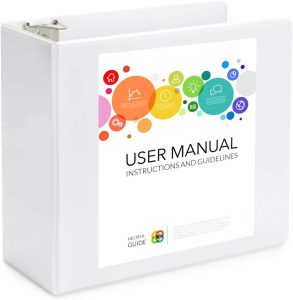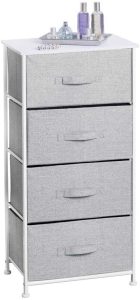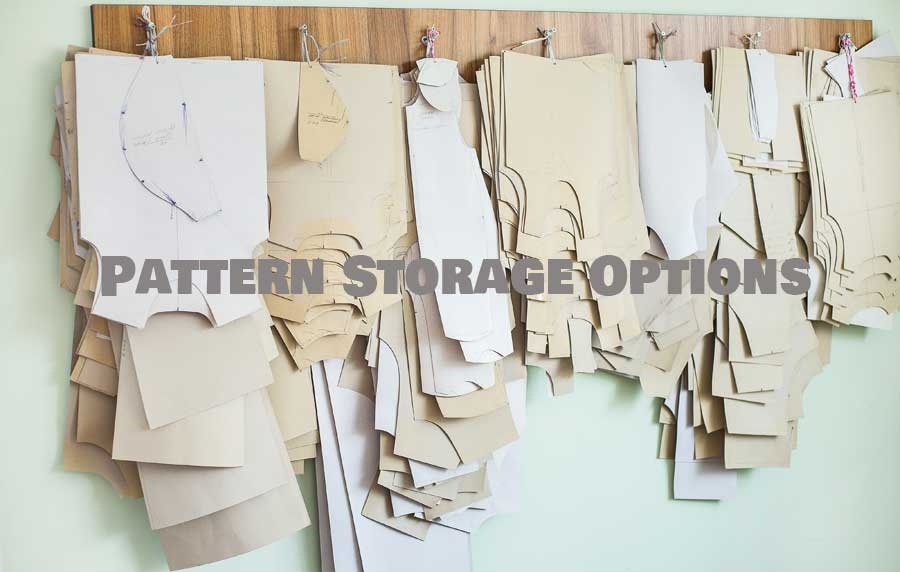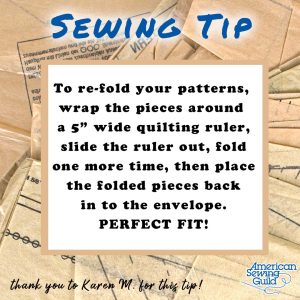There’s nothing more challenging that having a burgeoning pile of pattern tissue and trying to fold it all neatly back into its original envelope without tearing either the pattern or the envelope. It’s one of those “How did they get it all in there?” questions. (Truth be told, a machine does it at the factory.)
The question becomes, what’s the best way to store sewing patterns to keep them neat and make them easy to find for your next project? The more patterns you own, the harder this becomes. But first you need to analyze your space as that can determine your preferred method of organizing.
Also, as you probably have noticed, not all pattern brands have the same size envelopes, creating yet another challenge. Then there are those patterns you downloaded as PDF files, traced from a magazine, or drafted yourself. So, let’s explore some ideas.
Organizing Options

- Some sewists like to store patterns by category—pants, dresses, skirts, etc.—making them easy to find for a specific project. Other categories include home décor, accessories and crafts. If you have a lot of craft patterns, you may want to break down the categories further—maybe aprons, hats, totes, baskets, holiday, etc.
- If you’ve got a pattern stash for multiple family members, you may opt to separate them by name. Or, perhaps by size range—men, women, kids, plus sizes.
- Other sewers like to keep all patterns of a given brand together, and then perhaps sort them by number within the branded group.
- So, decision #1 is how do you want to organize your patterns. Decision #2 becomes how best to manage the inventory, and there are many great methods.
Binders

Having a binder of pattern options is like perusing the pattern catalogs at the fabric store, only these are all yours. Invest in some plastic sleeve protectors and place one pattern’s folded tissue and the envelope into the page protector, then file them in large binders using one of the organizing methods noted above.
Another binder option is to stow only the envelope in the page protector, and store the innards in a separate location labeled by pattern brand/number. Binders are available with 5” rings that will hold hundreds of pattern sleeves.
Drawers/Boxes/File Cabinets/Baskets
 If you opt to stow your patterns in a drawer, box, basket, etc., the same clear plastic options can be used, or purchase manila envelopes, place the tissue and instructions inside, then cut the envelope apart and glue the front and back onto the envelope.
If you opt to stow your patterns in a drawer, box, basket, etc., the same clear plastic options can be used, or purchase manila envelopes, place the tissue and instructions inside, then cut the envelope apart and glue the front and back onto the envelope.
Depending on the size of the container, you may also be able to just stand the original pattern envelopes up in rows, assuming the tissue is stuffed inside, or you’ve opted for plastic/manila sleeves.
Technology to the Rescue
 It’s helpful to create a database of patterns, if you’re sew inclined. This allows you to cross-reference by brand, number, garment type and size. If you scan the pattern envelope front and back, you can have a quick guide to the fabric amounts, etc. and if your database is accessible on a mobile device, it can be used while shopping. Most databases allow your pattern inventory to be shared with others—like if some family members you sew for live elsewhere.
It’s helpful to create a database of patterns, if you’re sew inclined. This allows you to cross-reference by brand, number, garment type and size. If you scan the pattern envelope front and back, you can have a quick guide to the fabric amounts, etc. and if your database is accessible on a mobile device, it can be used while shopping. Most databases allow your pattern inventory to be shared with others—like if some family members you sew for live elsewhere.
And, who hasn’t purchased the same pattern twice, not realizing you already owned it? Having access to your current pattern inventory can eliminate that issue.
Some software programs to explore for pattern organizing include Evernote, Trello, Tap Forms, and Dropbox.
Special Needs
Dressmakers: If you’re a dressmaker, you may have several patterns with custom alterations—someone’s favorite shirt or pants made just for them. If the patterns are made from tagboard, it’s easy to punch a hole in them, hang the pieces, then label them with the client’s name and date. These hang easily on a closet rod, hooks or metal rack.

Costume Maker: If you’re a costume maker or work with a theater group, perhaps you want to organize your patterns by era, so you can access something period appropriate for a performance. Maybe you further delineate by male/female or child/adult.
Bridal: Bridal work requires larger pieces than daywear, so the hanging option may be a good one for veil, train and petticoat patterns common to many styles.
How do the Pros do it?
We asked three industry professionals how they store their patterns:
Deanna Springer
Vice President of Marketing, Host/Producer, Stitch it! Sisters, Nancy Zieman Productions, LLC
To keep my sewing patterns organized, I store them in reusable pattern pouches that are see-through, waterproof and have a zippered closure. I can easily see what’s inside and they’re big enough to hold all the tissue without trying to restuff it into the original envelope.
Rhonda Pierce
Spokesperson, SCHMETZneedles.com/Vice President, Euro-notions
My pattern stash organization is three-fold: Used patterns, never to be made again but can’t bear to toss or donate, are stored in a giant box in the garage. Patterns waiting to be made are neatly organized in a basket in my sewing room awaiting fabric and stitch time. Favorite patterns are dropped into a zip-top bag and hung with completed projects for easy reference and perhaps made again.
Kenneth D. King
designer
I draft my own patterns on fairly robust white kraft paper. Once I get a pattern perfected, I have two legal-sized envelopes—one for the initial working draft, one for the finished pattern. I label it, with the name, date it was finished (month and year), and on the envelope, I make any notes I need to construct it. If it goes on to be part of my output for customers, I will note the customer, the serial number of the piece on the envelope as well. They store in my filing cabinet—the newer work in the upper drawers, older in the lower. Patterns that I use rarely live in a big banker’s file storage box in my office. So, nothing fancy. I don’t spend more time storing them, as I prefer to spend that time sewing.
~Linda Griepentrog
Linda is the owner of G Wiz Creative Services and she does writing, editing and designing for companies in the sewing, crafting and quilting industries. In addition, she escorts fabric shopping tours to Hong Kong. She lives at the Oregon Coast with her husband Keith, and two dogs, Yohnuh and Abby. Contact her at .






